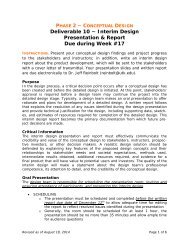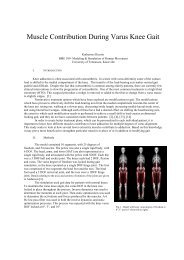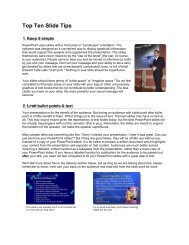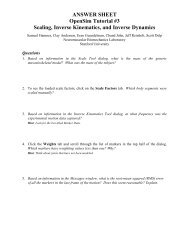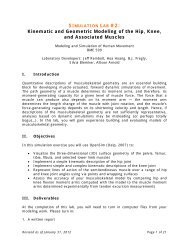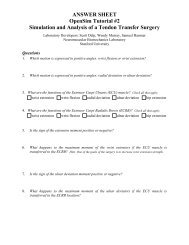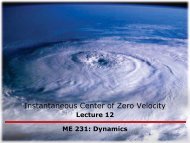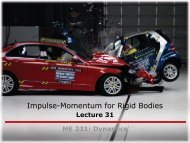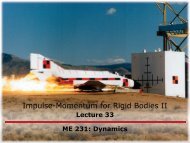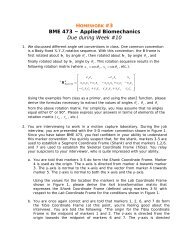Biomechanics of Movement
Biomechanics of Movement
Biomechanics of Movement
You also want an ePaper? Increase the reach of your titles
YUMPU automatically turns print PDFs into web optimized ePapers that Google loves.
Figure 1: Marker Convention
Kinematics1. Please calculate and plot the hip, knee, and ankle flexion angles as a function <strong>of</strong>time. (Note that you have more than 1 gait cycle in the data file.) To do so,follow these steps:a. Get the joint center for the hip, knee, and ankle joints. To get joint centersfrom marker position, all you need to do is subtract <strong>of</strong>f the values <strong>of</strong> the jointcenter correction factor (jcf) <strong>of</strong>f <strong>of</strong> the x-coordinate <strong>of</strong> the hip, knee, or anklemarker.b. Establish the vectors that represent the HAT (head, arms, torso), thigh(femur), shank (tibia and fibula), and foot. Please have all vectors originatingat the distal point and being directed proximally. (For example, the femur isdefined by hip - knee).c. Normalize the vectors that represent the HAT, thigh, shank, and foot.d. Calculate the angle between the y-axis in the global coordinate system andvectors representing the HAT, femur, and tibia. (Figure 2). (Hint: use the dotproduct)e. Calculate the angle between the z-axis and vector representing the foot.f. Calculate the hip, knee, and ankle angles with the following formulasi. Hip angle = thigh angle - HAT angleii. Knee angle = thigh angle - shank angleiii. Ankle angle = foot angle - shank angleg. Plot your results.2. Label when heel strike and toe <strong>of</strong>f occur on the three plots you just created.3. Differentiate your angles for the foot, shank, thigh, and HAT to obtain theappropriate angular velocities and accelerations. Use the following formulas toconduct this numerical differentiation. The camera samples at 120 Hz. You don’tneed to find the velocities and accelerations for the first and last data points.f ′f ′′f ( ti+ 1)− f ( ti−( ti) ≈2∆tf ( ti−1)− 2f( ti( ti) ≈2∆t1)) + f ( t4. Numerically differentiate your knee and ankle position data to obtain theappropriate linear velocities and accelerations for these markers. You don’t needto find the velocities and accelerations for the first and last data points.i + 1)
Figure 2: Linkage Model
Kinetics5. The moment <strong>of</strong> inertia and center <strong>of</strong> mass <strong>of</strong> each segment is needed to performinverse dynamic analysis. Anthropometric information from Winter (1990) canbe used to calculate this information. Using the data in the table below, calculatethe mass <strong>of</strong> the segment, the length <strong>of</strong> the segment, the position <strong>of</strong> the center<strong>of</strong> mass (COM) in the segment, and the moment <strong>of</strong> inertia about the center <strong>of</strong>mass for the foot, shank (tibia and fibula), thigh (femur), and HAT. Assumelinear segments as shown in the figure.A B C D ESegmentSegmentmass/ totalmassSegmentlength/heightCOM positionfromproximal end<strong>of</strong> segment/segmentlengthRadius <strong>of</strong>gyrationabout COM/segmentlengthFoot 0.0145 0.055 0.5 0.475Shank 0.0465 0.246 0.433 0.302Thigh 0.1 0.245 0.433 0.323HAT 0.678 0.47 0.626 0.496The height <strong>of</strong> the subject is 1.7526 m, and the mass <strong>of</strong> the subject is 66.7 kg.Columns B-D are fractions that should be scaled by total mass, height, orsegment length as listed.Moment <strong>of</strong> inertia <strong>of</strong> a segment is defined as:I = mass *(radius _ <strong>of</strong> _ gyration)2Radius <strong>of</strong> gyration should be determined from the information given.6. Please plot the vertical and horizontal ground reaction forces during the stancephase as a percentage <strong>of</strong> body weight.7. Draw a free body diagram for the foot, shank, thigh, and HAT segments. Youmay ignore the mass and moment <strong>of</strong> inertia <strong>of</strong> the foot, as it is sometimesassumed that the mass <strong>of</strong> the foot is negligible when compared to the mass <strong>of</strong>shank.8. Using homework 3 problem 4 as a primer, please derive the equations necessaryto solve for the torques about the hip, knee, and ankle joints during the stancephase <strong>of</strong> gait for this model. Again, for simplicity, you may ignore the mass <strong>of</strong>the foot. Some things to consider:
a. The location <strong>of</strong> the origin <strong>of</strong> the coordinate system for this problem isdifferent than the location <strong>of</strong> the coordinate system in homework 3.Therefore, you are measuring positions, velocities, and accelerations withrespect to a fixed laboratory reference frame. Think about how this changesyour equations from the ones you had in homework 3.b. You have markers at the hip, knee, and ankle joints. Think about how youcan use this information to simplify your equations from those used inhomework 3.9. For the given data, please use the equations you just derived in problem 8 tocalculate the torques for the hip, knee, and ankle joints during the stance phase<strong>of</strong> gait. (Note: when solving the equations, remember that all angular velocitiesand accelerations need to be in radians).Plot your results and normalize themwith respect to body mass (i.e., units are Nm/kg).Discussion10.You used anthropometric data to determine the lengths <strong>of</strong> the segments in thisassignment. Suppose Ted (<strong>of</strong> homework 2 fame) wants to work with you andsuggests that you could just use motion data to determine segment length. Tedsays that the magnitude <strong>of</strong> the distance between any 2 markers in the 6-markerconvention could give you the appropriate segment length.To test Ted’s idea, plot the magnitude <strong>of</strong> the vector between the hip and kneefor all <strong>of</strong> the time points in this study. Comment on the behavior <strong>of</strong> the curveyou just plotted and compare this magnitude to the length <strong>of</strong> the thighdetermined in problem 5. Comment on some possible explanations for theobserved differences.11.In problem 9, you were asked to normalize the joint torques by body mass. Whyis it important to perform this normalization instead <strong>of</strong> just reporting a raw valuein Newton-meters?12.Which joint moment has the greatest magnitude (hip, knee, or ankle)? Couldyou suggest an explanation as to why this is the case?13.Look at the shapes <strong>of</strong> the curves for the hip and knee torques in early stance.Please suggest a few explanations for what you observe and propose somepossible solutions to correct the problem. (Hints: consider your results forproblems 6 and 10. Also, what type <strong>of</strong> marker and force plate data are youworking with?).FeedbackHow long did it take for you to complete this assignment? I am constantly changingand updating assignments, so this information is useful to me.



